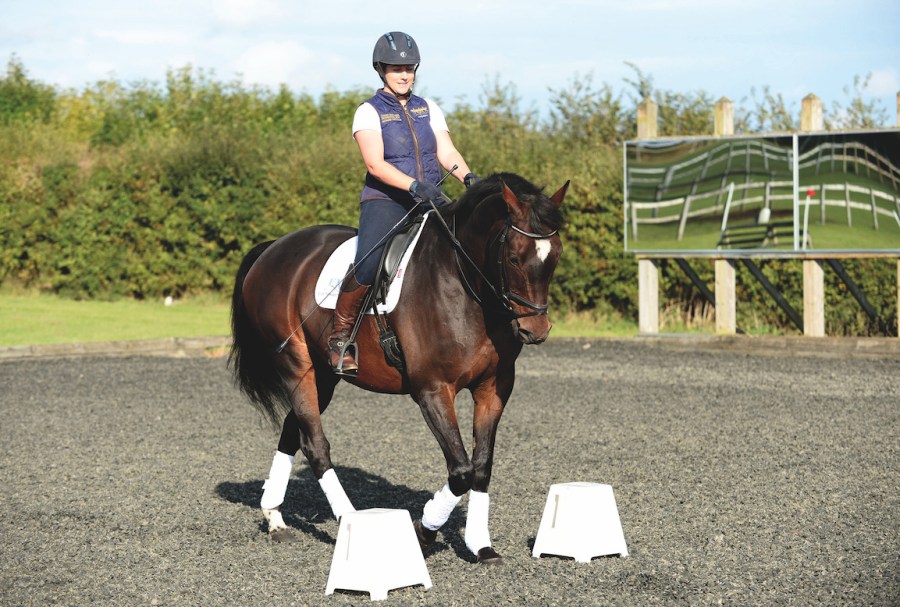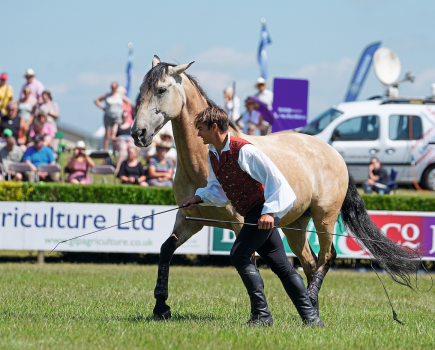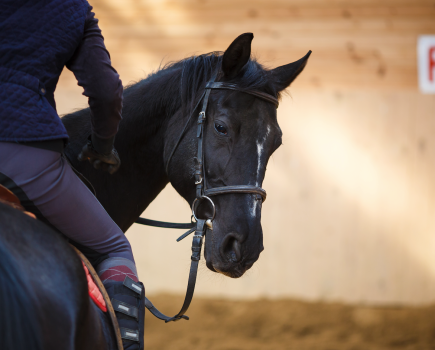It’s easy to fall into bad habits when training at home without an instructor for guidance. Turn things around with this simple tip and four exercises from UKCC Level 2 British Dressage-registered trainer Wade Barley.
According to him, there’s a super-simple way to add focus and discipline to every schooling session: just grab some blocks!
“Cones, poles, jump wings or whatever you have to hand will work just as well,” explains Wade. “Simply place two blocks a few feet apart in your schooling area to give you something to aim for, as well as a fixed point at which to ask for a transition change. You might place four sets of blocks on a circle, but there are no hard and fast rules. If you prefer, place your blocks in each corner of the arena or along each long side.”
Exercise 1: Have a focus point
Set up four sets of blocks on a circle, with each pair of blocks around 4ft apart.
“This is a really straightforward exercise I use for all levels of rider,” he explains. “Put simply, the blocks act as a focus point — something to aim for, ride through and use as a guide for transition changes.”
How to ride it:
- Start by placing your sets of blocks a few feet apart on a circle, so that you can pass between them.
- Walk through each set of blocks, aiming for the middle of each ‘tunnel’.
- Repeat this on both reins, aiming for a regular walk rhythm and keeping your horse between your hand and leg.
- Next, choose a set of blocks and, as you approach them, prepare for a walk-trot transition.
- Ask for the transition between the blocks.
Exercise 2: Be precise and decisive
As Wade explains, the trick to this exercise is all in the detail.
“Be strict and ride positively. Make sure each transition happens between the blocks — not just before or just after.
“Whatever level you’re training at, riding between two blocks is a useful aid. Walk to trot transitions, gear changes in canter, flying changes… whatever you’re asking for, ask for it within the blocks.”
How to ride it:
- Pick a set of blocks and decide which transition you’re going to ask for as you ride through them.
- Be strict! The transition must only happen between the blocks.
- Ask for gear changes within the pace at each set of blocks, as well as upwards and downwards transitions.
Exercise 3: Be your horse’s leader
As well as honing your accuracy and giving you something to aim for, this next exercise helps to boost your confidence and control.
You, the rider, are the one in charge, and you have the power to control your horse’s paces and help him stay supple and move in self-carriage as he works in a circle through the blocks.
“Remember your six Scales of Training,” says Wade. “Think rhythm, suppleness, contact, impulsion, straightness and collection.”
How to ride it:
- Look up and ahead to each set of blocks and commit to your chosen transition.
- Ride in a light seat through each transition so that your horse can lift and round his back.
- Horse feel a little heavy on one rein? Simply flex him more to the opposite side.
- Be consistent in the contact and keep an elastic feel along the reins so there’s nothing for your horse to brace against.
- Keep refreshing the pace between the blocks and switch up gears if needs be.
- In trot, make it a priority to get on the correct diagonal straight away…
- …but if your horse feels crooked in trot, deliberately ride on the wrong diagonal for a few strides to encourage him to really use his outside hind leg.
- The above is a good suppling exercise and you can go back to riding on the correct leg as a reward
Exercise 4: Commit to a plan
Charlotte explains that she can struggle to hold Buddy together in canter, so Wade suggests lots of gear changes within this pace to really up the ante and boost her confidence and control.
How to ride it:
- Start by cantering large so you can get a feel for the correct rhythm and pace.
- Keep this correct canter rhythm as you switch to riding between the blocks.
- Be brave, strict and positive. Really commit to each transition between the blocks.
- Ask for a trot-canter transition between the blocks, then canter-trot, trot-walk and walk-canter — enjoy playing around with this exercise.
- As well as direct transitions, ask for changes of gear through the blocks.
- In canter, transition from third gear to fourth, then return to third gear.
- Keep playing around with these gear changes — third to fourth, back to third, down to second, and so on.
- Remember, you dictate the pace.









